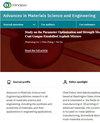利用石榴皮和菠萝皮提取物生成高效生物电化学电池并绿色合成银纳米粒子:综合表征研究
4区 材料科学
Q2 Engineering
引用次数: 0
摘要
本研究采用石榴皮(PgP)和菠萝皮(PnP)提取物,研究了一种具有环保意识的银纳米粒子(AgNPs)合成方法。这种绿色合成方法为传统化学方法提供了一种可持续的替代方法,从而减少了与纳米粒子生产相关的生态足迹。在合成过程中,PgP 和 PnP 提取物既是还原剂,又是封端剂,从而提高了生成的 AgNPs 的生物相容性。利用各种表征技术,包括紫外可见光谱、拉曼分析、X 射线衍射 (XRD)、动态光散射 (DLS)、傅立叶变换红外 (FTIR) 和透射电子显微镜 (TEM) 来分析合成的 AgNPs。紫外可见光谱通过特征性的表面等离子共振峰确认了 AgNPs 的形成,而傅立叶变换红外光谱则检测了生物材料成分之间的相互作用以及银纳米粒子的氧化和包覆。拉曼分析阐明了负责还原和稳定 AgNPs 的官能团,而 XRD 则提供了对其晶体结构的深入了解。TEM 图像显示了纳米颗粒的尺寸和形态,而 DLS 则描述了它们的平均尺寸和形态。此外,还将合成的 AgNPs 用于生物电化学电池,利用其独特的性质提高电化学性能,展示了它们在能量存储和转换系统中的潜在应用。总之,这项研究证明了利用 PgP 和 PnP 等农业废弃物进行可持续 AgNP 合成的可行性,为环境友好型纳米技术的发展提供了广阔的前景。本文章由计算机程序翻译,如有差异,请以英文原文为准。
Efficient Bioelectrochemical Cell Generation and Green Synthesis of Silver Nanoparticles Using Pomegranate and Pineapple Peel Extracts: A Comprehensive Characterization Study
The present study investigates an environmentally conscious method for synthesizing silver nanoparticles (AgNPs) by employing extracts from pomegranate peel (PgP) and pineapple peel (PnP). This green synthesis approach offers a sustainable alternative to traditional chemical methods, thereby reducing the ecological footprint associated with nanoparticle production. The PgP and PnP extracts serve as both reducing and capping agents during the synthesis process, enhancing the biocompatibility of the resultant AgNPs. Various characterization techniques, including UV-Vis spectroscopy, Raman analysis, X-ray diffraction (XRD), dynamic light scattering (DLS), Fourier transform infrared (FTIR), and transmission electron microscopy (TEM), were utilized to analyze the synthesized AgNPs. UV-Vis spectroscopy confirmed the formation of AgNPs through characteristic surface plasmon resonance peaks, while FTIR examined the interaction between biomaterial components and the oxidation and coating of silver nanoparticles. Raman analysis elucidated the functional groups responsible for reducing and stabilizing AgNPs, while XRD provided insights into their crystalline structure. TEM images revealed the size and morphology of the nanoparticles, while DLS characterized their average size and morphology. In addition, the synthesized AgNPs were utilized in a bioelectrochemical cell to leverage their unique properties for enhanced electrochemical performance, showcasing their potential application in energy storage and conversion systems. Overall, this study demonstrates the feasibility of utilizing agricultural waste products such as PgP and PnP for sustainable AgNP synthesis, offering promising prospects for environmentally friendly nanotechnology advancement.
求助全文
通过发布文献求助,成功后即可免费获取论文全文。
去求助
来源期刊

Advances in Materials Science and Engineering
Materials Science-General Materials Science
CiteScore
3.30
自引率
0.00%
发文量
0
审稿时长
4-8 weeks
期刊介绍:
Advances in Materials Science and Engineering is a broad scope journal that publishes articles in all areas of materials science and engineering including, but not limited to:
-Chemistry and fundamental properties of matter
-Material synthesis, fabrication, manufacture, and processing
-Magnetic, electrical, thermal, and optical properties of materials
-Strength, durability, and mechanical behaviour of materials
-Consideration of materials in structural design, modelling, and engineering
-Green and renewable materials, and consideration of materials’ life cycles
-Materials in specialist applications (such as medicine, energy, aerospace, and nanotechnology)
 求助内容:
求助内容: 应助结果提醒方式:
应助结果提醒方式:


